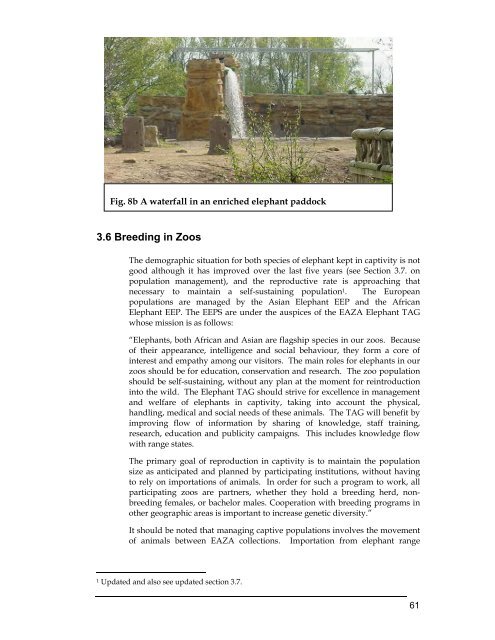Elephants Elephants - Wildpro - Twycross Zoo
Elephants Elephants - Wildpro - Twycross Zoo
Elephants Elephants - Wildpro - Twycross Zoo
Create successful ePaper yourself
Turn your PDF publications into a flip-book with our unique Google optimized e-Paper software.
Fig. 8b A waterfall in an enriched elephant paddock<br />
3.6 Breeding in <strong>Zoo</strong>s<br />
The demographic situation for both species of elephant kept in captivity is not<br />
good although it has improved over the last five years (see Section 3.7. on<br />
population management), and the reproductive rate is approaching that<br />
necessary to maintain a self-sustaining population 1. The European<br />
populations are managed by the Asian Elephant EEP and the African<br />
Elephant EEP. The EEPS are under the auspices of the EAZA Elephant TAG<br />
whose mission is as follows:<br />
“<strong>Elephants</strong>, both African and Asian are flagship species in our zoos. Because<br />
of their appearance, intelligence and social behaviour, they form a core of<br />
interest and empathy among our visitors. The main roles for elephants in our<br />
zoos should be for education, conservation and research. The zoo population<br />
should be self-sustaining, without any plan at the moment for reintroduction<br />
into the wild. The Elephant TAG should strive for excellence in management<br />
and welfare of elephants in captivity, taking into account the physical,<br />
handling, medical and social needs of these animals. The TAG will benefit by<br />
improving flow of information by sharing of knowledge, staff training,<br />
research, education and publicity campaigns. This includes knowledge flow<br />
with range states.<br />
The primary goal of reproduction in captivity is to maintain the population<br />
size as anticipated and planned by participating institutions, without having<br />
to rely on importations of animals. In order for such a program to work, all<br />
participating zoos are partners, whether they hold a breeding herd, nonbreeding<br />
females, or bachelor males. Cooperation with breeding programs in<br />
other geographic areas is important to increase genetic diversity.”<br />
It should be noted that managing captive populations involves the movement<br />
of animals between EAZA collections. Importation from elephant range<br />
1 Updated and also see updated section 3.7.<br />
61

















